Research Proposal: Double Burden of Malnutrition in Pakistan
VerifiedAdded on 2022/08/20
|8
|1855
|20
Project
AI Summary
This research proposal outlines a study on the double burden of malnutrition (DBM) in Pakistan, defined by the simultaneous presence of under-nutrition and over-nutrition. It aims to explore the relationship between DBM and socioeconomic inequities, including factors like income, education, healthcare access, and food/water availability. The research will employ a systematic review methodology, searching databases like CINAHL, Medline, and PubMed for articles published from 2016-2020 using keywords related to DBM, socioeconomic factors, and Pakistan. Data analysis will involve thematic analysis to synthesize findings. The proposal highlights the strengths of a systematic review, such as its comprehensive scope, while acknowledging limitations like publication bias. To ensure validity, the study will prioritize high-quality studies and utilize a critical appraisal tool. The findings are expected to provide insights for public health interventions and will be disseminated to relevant authorities. The study builds on existing evidence of DBM in Pakistan, citing research that links it to factors like lack of breastfeeding and media access.
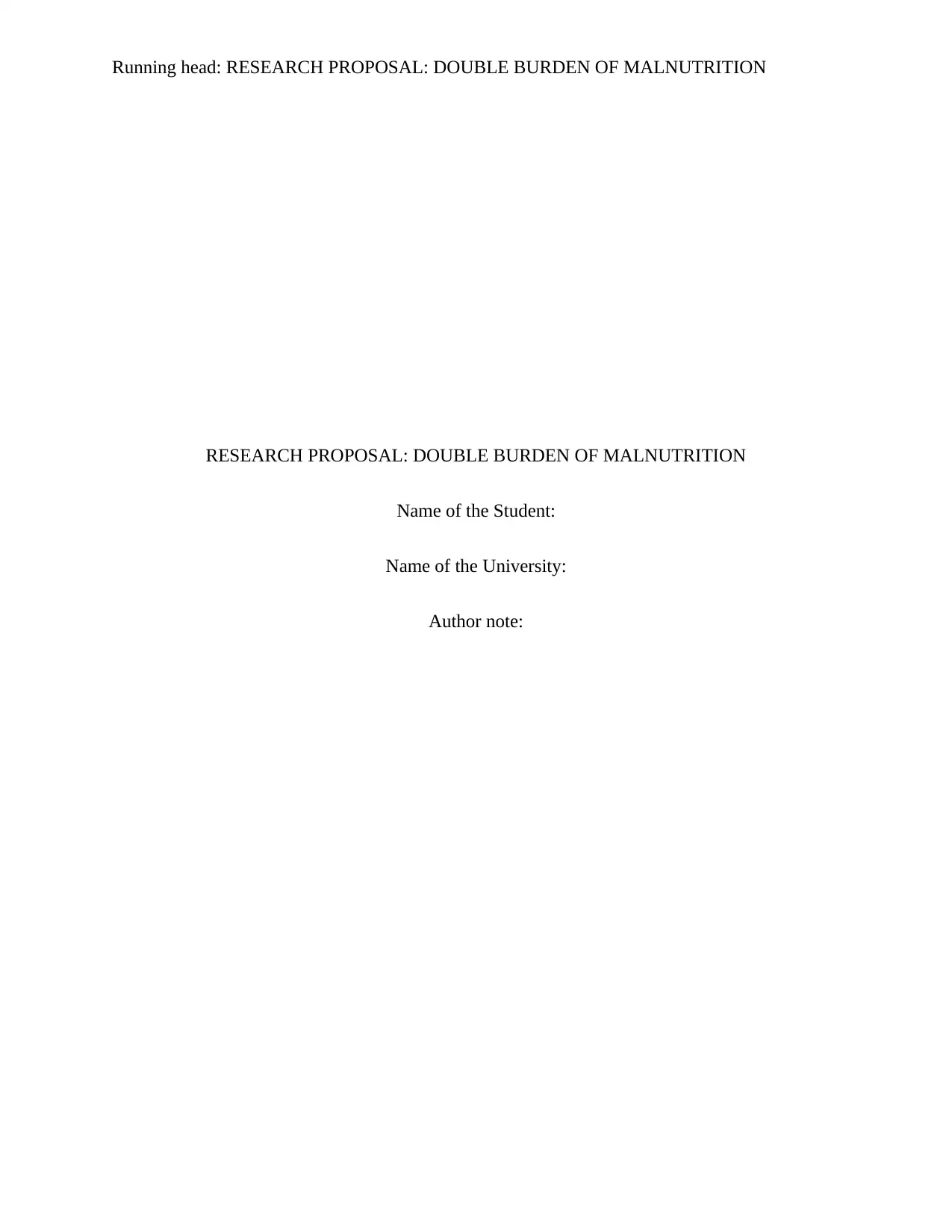
Running head: RESEARCH PROPOSAL: DOUBLE BURDEN OF MALNUTRITION
RESEARCH PROPOSAL: DOUBLE BURDEN OF MALNUTRITION
Name of the Student:
Name of the University:
Author note:
RESEARCH PROPOSAL: DOUBLE BURDEN OF MALNUTRITION
Name of the Student:
Name of the University:
Author note:
Paraphrase This Document
Need a fresh take? Get an instant paraphrase of this document with our AI Paraphraser
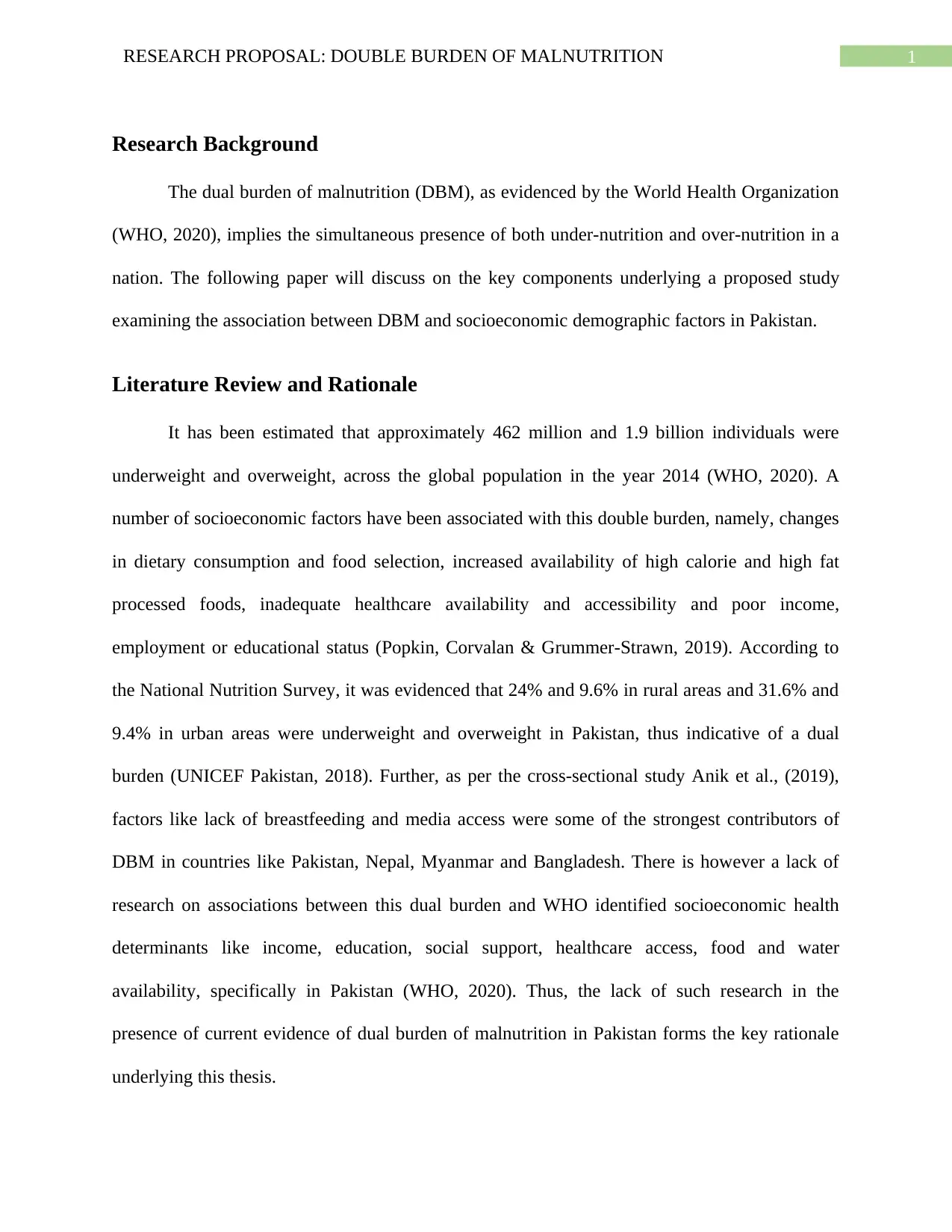
1RESEARCH PROPOSAL: DOUBLE BURDEN OF MALNUTRITION
Research Background
The dual burden of malnutrition (DBM), as evidenced by the World Health Organization
(WHO, 2020), implies the simultaneous presence of both under-nutrition and over-nutrition in a
nation. The following paper will discuss on the key components underlying a proposed study
examining the association between DBM and socioeconomic demographic factors in Pakistan.
Literature Review and Rationale
It has been estimated that approximately 462 million and 1.9 billion individuals were
underweight and overweight, across the global population in the year 2014 (WHO, 2020). A
number of socioeconomic factors have been associated with this double burden, namely, changes
in dietary consumption and food selection, increased availability of high calorie and high fat
processed foods, inadequate healthcare availability and accessibility and poor income,
employment or educational status (Popkin, Corvalan & Grummer-Strawn, 2019). According to
the National Nutrition Survey, it was evidenced that 24% and 9.6% in rural areas and 31.6% and
9.4% in urban areas were underweight and overweight in Pakistan, thus indicative of a dual
burden (UNICEF Pakistan, 2018). Further, as per the cross-sectional study Anik et al., (2019),
factors like lack of breastfeeding and media access were some of the strongest contributors of
DBM in countries like Pakistan, Nepal, Myanmar and Bangladesh. There is however a lack of
research on associations between this dual burden and WHO identified socioeconomic health
determinants like income, education, social support, healthcare access, food and water
availability, specifically in Pakistan (WHO, 2020). Thus, the lack of such research in the
presence of current evidence of dual burden of malnutrition in Pakistan forms the key rationale
underlying this thesis.
Research Background
The dual burden of malnutrition (DBM), as evidenced by the World Health Organization
(WHO, 2020), implies the simultaneous presence of both under-nutrition and over-nutrition in a
nation. The following paper will discuss on the key components underlying a proposed study
examining the association between DBM and socioeconomic demographic factors in Pakistan.
Literature Review and Rationale
It has been estimated that approximately 462 million and 1.9 billion individuals were
underweight and overweight, across the global population in the year 2014 (WHO, 2020). A
number of socioeconomic factors have been associated with this double burden, namely, changes
in dietary consumption and food selection, increased availability of high calorie and high fat
processed foods, inadequate healthcare availability and accessibility and poor income,
employment or educational status (Popkin, Corvalan & Grummer-Strawn, 2019). According to
the National Nutrition Survey, it was evidenced that 24% and 9.6% in rural areas and 31.6% and
9.4% in urban areas were underweight and overweight in Pakistan, thus indicative of a dual
burden (UNICEF Pakistan, 2018). Further, as per the cross-sectional study Anik et al., (2019),
factors like lack of breastfeeding and media access were some of the strongest contributors of
DBM in countries like Pakistan, Nepal, Myanmar and Bangladesh. There is however a lack of
research on associations between this dual burden and WHO identified socioeconomic health
determinants like income, education, social support, healthcare access, food and water
availability, specifically in Pakistan (WHO, 2020). Thus, the lack of such research in the
presence of current evidence of dual burden of malnutrition in Pakistan forms the key rationale
underlying this thesis.
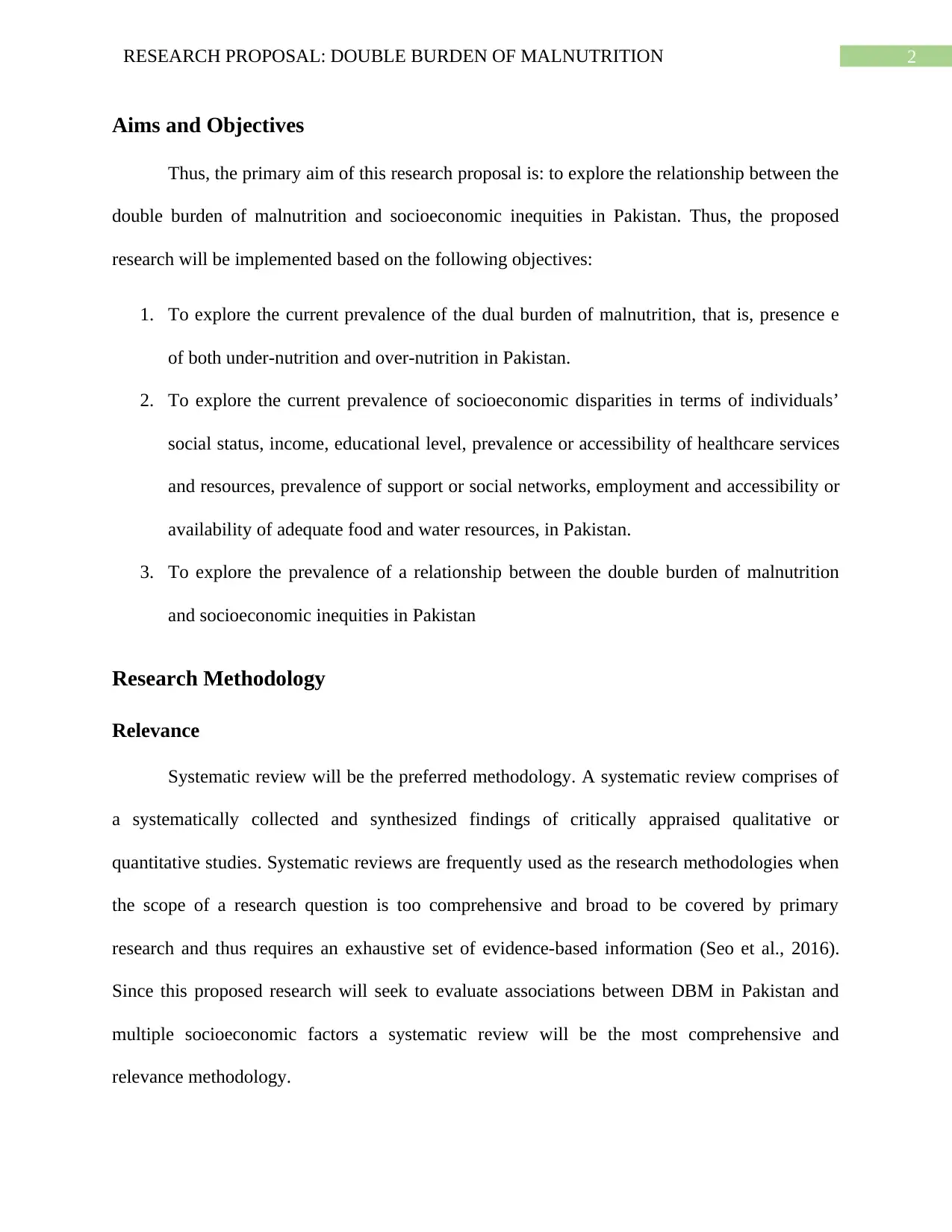
2RESEARCH PROPOSAL: DOUBLE BURDEN OF MALNUTRITION
Aims and Objectives
Thus, the primary aim of this research proposal is: to explore the relationship between the
double burden of malnutrition and socioeconomic inequities in Pakistan. Thus, the proposed
research will be implemented based on the following objectives:
1. To explore the current prevalence of the dual burden of malnutrition, that is, presence e
of both under-nutrition and over-nutrition in Pakistan.
2. To explore the current prevalence of socioeconomic disparities in terms of individuals’
social status, income, educational level, prevalence or accessibility of healthcare services
and resources, prevalence of support or social networks, employment and accessibility or
availability of adequate food and water resources, in Pakistan.
3. To explore the prevalence of a relationship between the double burden of malnutrition
and socioeconomic inequities in Pakistan
Research Methodology
Relevance
Systematic review will be the preferred methodology. A systematic review comprises of
a systematically collected and synthesized findings of critically appraised qualitative or
quantitative studies. Systematic reviews are frequently used as the research methodologies when
the scope of a research question is too comprehensive and broad to be covered by primary
research and thus requires an exhaustive set of evidence-based information (Seo et al., 2016).
Since this proposed research will seek to evaluate associations between DBM in Pakistan and
multiple socioeconomic factors a systematic review will be the most comprehensive and
relevance methodology.
Aims and Objectives
Thus, the primary aim of this research proposal is: to explore the relationship between the
double burden of malnutrition and socioeconomic inequities in Pakistan. Thus, the proposed
research will be implemented based on the following objectives:
1. To explore the current prevalence of the dual burden of malnutrition, that is, presence e
of both under-nutrition and over-nutrition in Pakistan.
2. To explore the current prevalence of socioeconomic disparities in terms of individuals’
social status, income, educational level, prevalence or accessibility of healthcare services
and resources, prevalence of support or social networks, employment and accessibility or
availability of adequate food and water resources, in Pakistan.
3. To explore the prevalence of a relationship between the double burden of malnutrition
and socioeconomic inequities in Pakistan
Research Methodology
Relevance
Systematic review will be the preferred methodology. A systematic review comprises of
a systematically collected and synthesized findings of critically appraised qualitative or
quantitative studies. Systematic reviews are frequently used as the research methodologies when
the scope of a research question is too comprehensive and broad to be covered by primary
research and thus requires an exhaustive set of evidence-based information (Seo et al., 2016).
Since this proposed research will seek to evaluate associations between DBM in Pakistan and
multiple socioeconomic factors a systematic review will be the most comprehensive and
relevance methodology.
⊘ This is a preview!⊘
Do you want full access?
Subscribe today to unlock all pages.

Trusted by 1+ million students worldwide
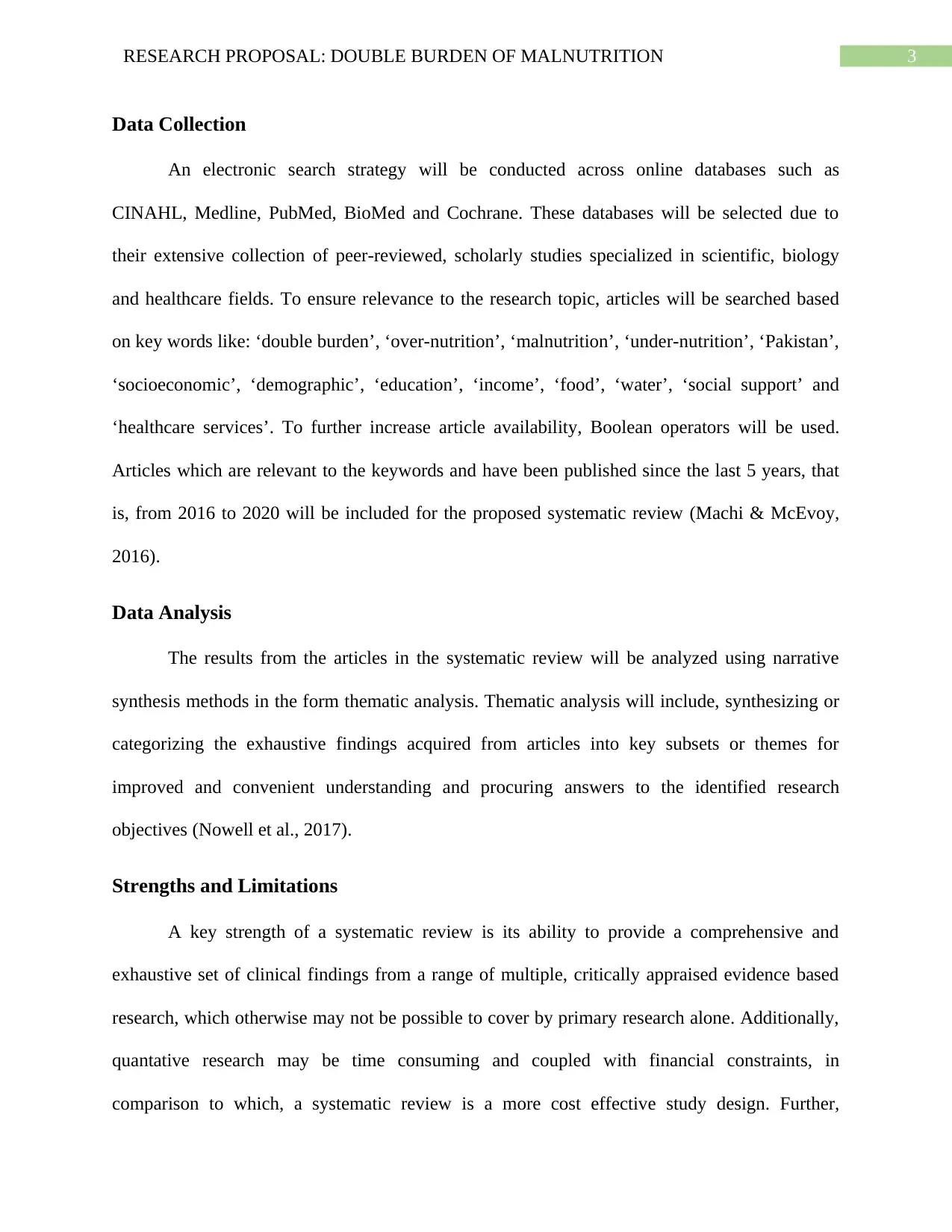
3RESEARCH PROPOSAL: DOUBLE BURDEN OF MALNUTRITION
Data Collection
An electronic search strategy will be conducted across online databases such as
CINAHL, Medline, PubMed, BioMed and Cochrane. These databases will be selected due to
their extensive collection of peer-reviewed, scholarly studies specialized in scientific, biology
and healthcare fields. To ensure relevance to the research topic, articles will be searched based
on key words like: ‘double burden’, ‘over-nutrition’, ‘malnutrition’, ‘under-nutrition’, ‘Pakistan’,
‘socioeconomic’, ‘demographic’, ‘education’, ‘income’, ‘food’, ‘water’, ‘social support’ and
‘healthcare services’. To further increase article availability, Boolean operators will be used.
Articles which are relevant to the keywords and have been published since the last 5 years, that
is, from 2016 to 2020 will be included for the proposed systematic review (Machi & McEvoy,
2016).
Data Analysis
The results from the articles in the systematic review will be analyzed using narrative
synthesis methods in the form thematic analysis. Thematic analysis will include, synthesizing or
categorizing the exhaustive findings acquired from articles into key subsets or themes for
improved and convenient understanding and procuring answers to the identified research
objectives (Nowell et al., 2017).
Strengths and Limitations
A key strength of a systematic review is its ability to provide a comprehensive and
exhaustive set of clinical findings from a range of multiple, critically appraised evidence based
research, which otherwise may not be possible to cover by primary research alone. Additionally,
quantative research may be time consuming and coupled with financial constraints, in
comparison to which, a systematic review is a more cost effective study design. Further,
Data Collection
An electronic search strategy will be conducted across online databases such as
CINAHL, Medline, PubMed, BioMed and Cochrane. These databases will be selected due to
their extensive collection of peer-reviewed, scholarly studies specialized in scientific, biology
and healthcare fields. To ensure relevance to the research topic, articles will be searched based
on key words like: ‘double burden’, ‘over-nutrition’, ‘malnutrition’, ‘under-nutrition’, ‘Pakistan’,
‘socioeconomic’, ‘demographic’, ‘education’, ‘income’, ‘food’, ‘water’, ‘social support’ and
‘healthcare services’. To further increase article availability, Boolean operators will be used.
Articles which are relevant to the keywords and have been published since the last 5 years, that
is, from 2016 to 2020 will be included for the proposed systematic review (Machi & McEvoy,
2016).
Data Analysis
The results from the articles in the systematic review will be analyzed using narrative
synthesis methods in the form thematic analysis. Thematic analysis will include, synthesizing or
categorizing the exhaustive findings acquired from articles into key subsets or themes for
improved and convenient understanding and procuring answers to the identified research
objectives (Nowell et al., 2017).
Strengths and Limitations
A key strength of a systematic review is its ability to provide a comprehensive and
exhaustive set of clinical findings from a range of multiple, critically appraised evidence based
research, which otherwise may not be possible to cover by primary research alone. Additionally,
quantative research may be time consuming and coupled with financial constraints, in
comparison to which, a systematic review is a more cost effective study design. Further,
Paraphrase This Document
Need a fresh take? Get an instant paraphrase of this document with our AI Paraphraser
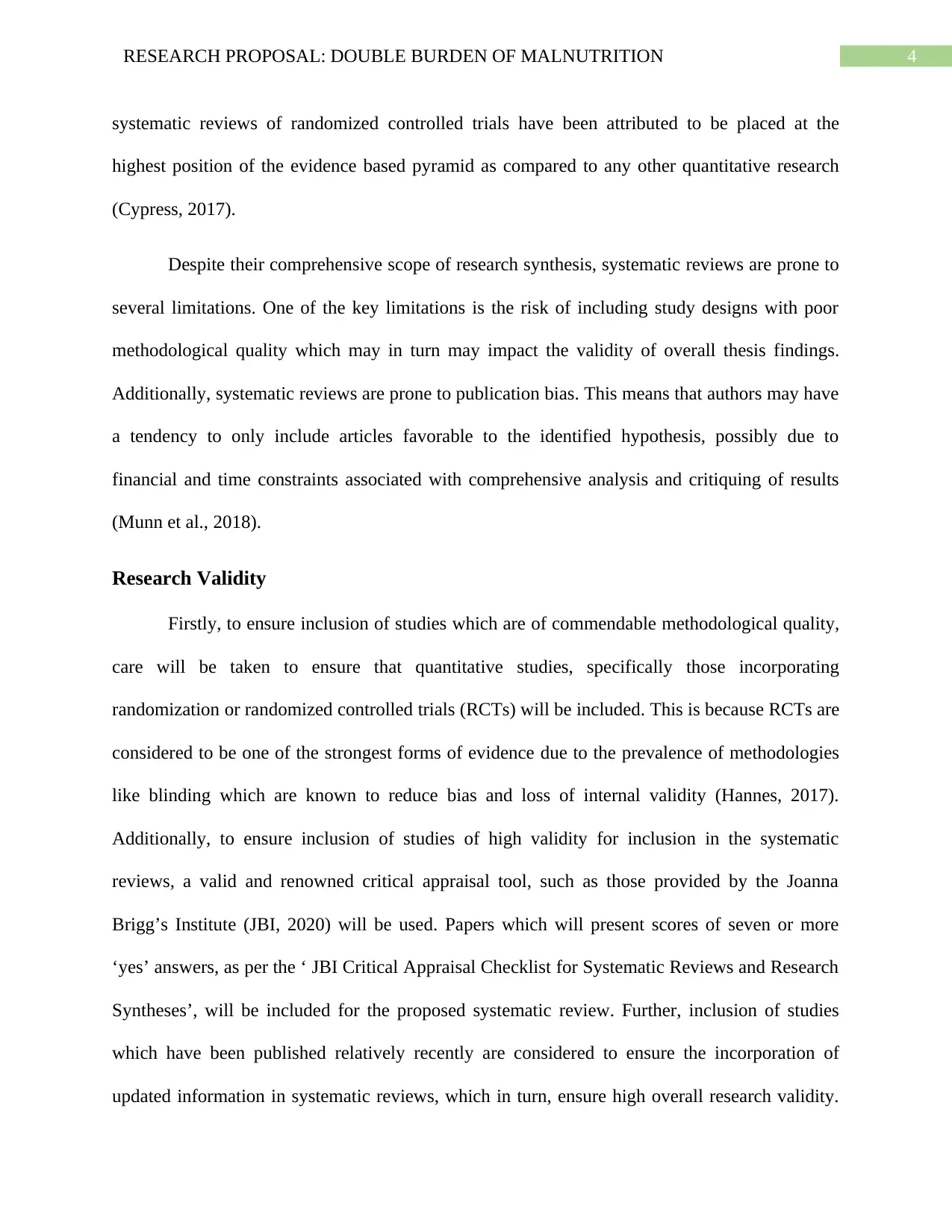
4RESEARCH PROPOSAL: DOUBLE BURDEN OF MALNUTRITION
systematic reviews of randomized controlled trials have been attributed to be placed at the
highest position of the evidence based pyramid as compared to any other quantitative research
(Cypress, 2017).
Despite their comprehensive scope of research synthesis, systematic reviews are prone to
several limitations. One of the key limitations is the risk of including study designs with poor
methodological quality which may in turn may impact the validity of overall thesis findings.
Additionally, systematic reviews are prone to publication bias. This means that authors may have
a tendency to only include articles favorable to the identified hypothesis, possibly due to
financial and time constraints associated with comprehensive analysis and critiquing of results
(Munn et al., 2018).
Research Validity
Firstly, to ensure inclusion of studies which are of commendable methodological quality,
care will be taken to ensure that quantitative studies, specifically those incorporating
randomization or randomized controlled trials (RCTs) will be included. This is because RCTs are
considered to be one of the strongest forms of evidence due to the prevalence of methodologies
like blinding which are known to reduce bias and loss of internal validity (Hannes, 2017).
Additionally, to ensure inclusion of studies of high validity for inclusion in the systematic
reviews, a valid and renowned critical appraisal tool, such as those provided by the Joanna
Brigg’s Institute (JBI, 2020) will be used. Papers which will present scores of seven or more
‘yes’ answers, as per the ‘ JBI Critical Appraisal Checklist for Systematic Reviews and Research
Syntheses’, will be included for the proposed systematic review. Further, inclusion of studies
which have been published relatively recently are considered to ensure the incorporation of
updated information in systematic reviews, which in turn, ensure high overall research validity.
systematic reviews of randomized controlled trials have been attributed to be placed at the
highest position of the evidence based pyramid as compared to any other quantitative research
(Cypress, 2017).
Despite their comprehensive scope of research synthesis, systematic reviews are prone to
several limitations. One of the key limitations is the risk of including study designs with poor
methodological quality which may in turn may impact the validity of overall thesis findings.
Additionally, systematic reviews are prone to publication bias. This means that authors may have
a tendency to only include articles favorable to the identified hypothesis, possibly due to
financial and time constraints associated with comprehensive analysis and critiquing of results
(Munn et al., 2018).
Research Validity
Firstly, to ensure inclusion of studies which are of commendable methodological quality,
care will be taken to ensure that quantitative studies, specifically those incorporating
randomization or randomized controlled trials (RCTs) will be included. This is because RCTs are
considered to be one of the strongest forms of evidence due to the prevalence of methodologies
like blinding which are known to reduce bias and loss of internal validity (Hannes, 2017).
Additionally, to ensure inclusion of studies of high validity for inclusion in the systematic
reviews, a valid and renowned critical appraisal tool, such as those provided by the Joanna
Brigg’s Institute (JBI, 2020) will be used. Papers which will present scores of seven or more
‘yes’ answers, as per the ‘ JBI Critical Appraisal Checklist for Systematic Reviews and Research
Syntheses’, will be included for the proposed systematic review. Further, inclusion of studies
which have been published relatively recently are considered to ensure the incorporation of
updated information in systematic reviews, which in turn, ensure high overall research validity.
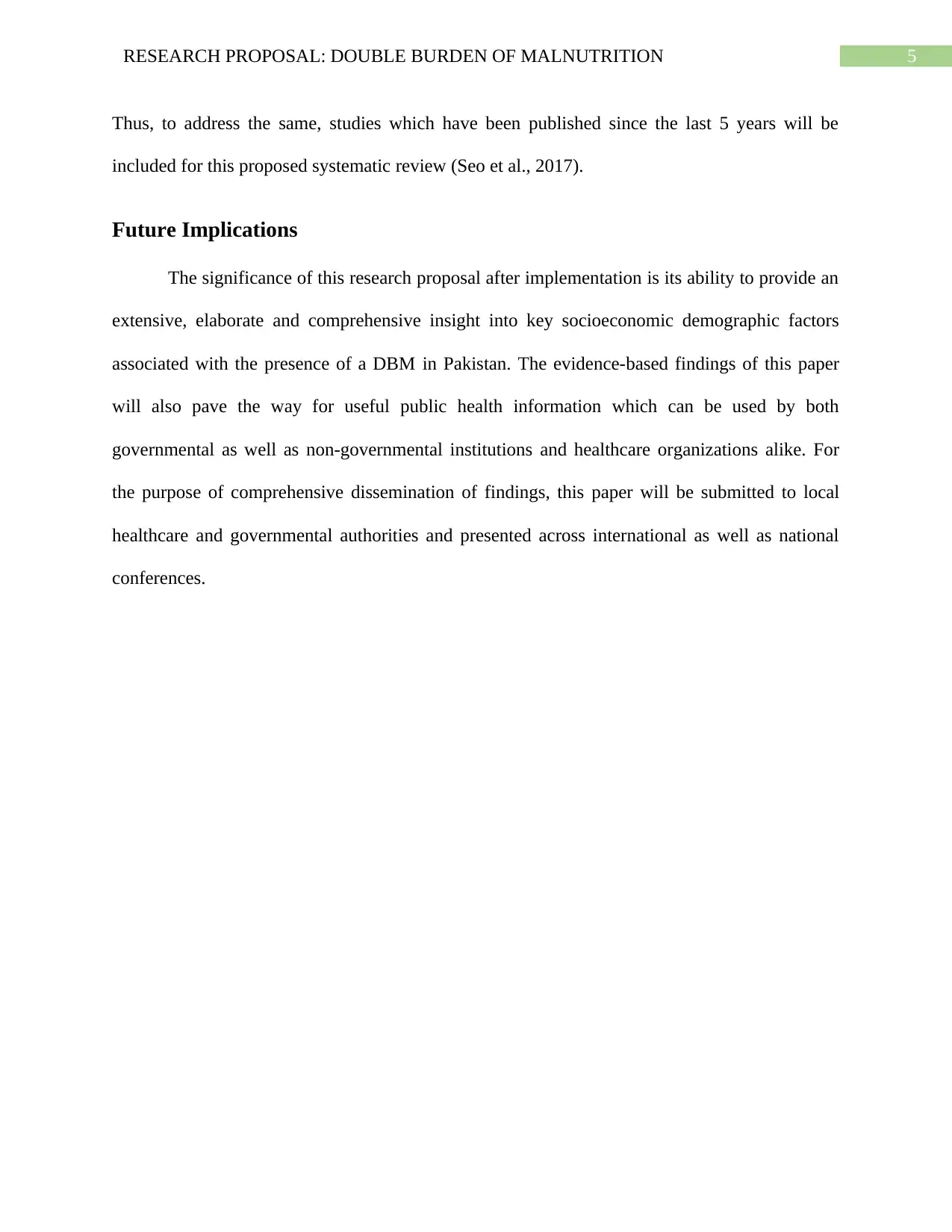
5RESEARCH PROPOSAL: DOUBLE BURDEN OF MALNUTRITION
Thus, to address the same, studies which have been published since the last 5 years will be
included for this proposed systematic review (Seo et al., 2017).
Future Implications
The significance of this research proposal after implementation is its ability to provide an
extensive, elaborate and comprehensive insight into key socioeconomic demographic factors
associated with the presence of a DBM in Pakistan. The evidence-based findings of this paper
will also pave the way for useful public health information which can be used by both
governmental as well as non-governmental institutions and healthcare organizations alike. For
the purpose of comprehensive dissemination of findings, this paper will be submitted to local
healthcare and governmental authorities and presented across international as well as national
conferences.
Thus, to address the same, studies which have been published since the last 5 years will be
included for this proposed systematic review (Seo et al., 2017).
Future Implications
The significance of this research proposal after implementation is its ability to provide an
extensive, elaborate and comprehensive insight into key socioeconomic demographic factors
associated with the presence of a DBM in Pakistan. The evidence-based findings of this paper
will also pave the way for useful public health information which can be used by both
governmental as well as non-governmental institutions and healthcare organizations alike. For
the purpose of comprehensive dissemination of findings, this paper will be submitted to local
healthcare and governmental authorities and presented across international as well as national
conferences.
⊘ This is a preview!⊘
Do you want full access?
Subscribe today to unlock all pages.

Trusted by 1+ million students worldwide

6RESEARCH PROPOSAL: DOUBLE BURDEN OF MALNUTRITION
References
Anik, A. I., Rahman, M. M., Rahman, M. M., Tareque, M. I., Khan, M. N., & Alam, M. M.
(2019). Double burden of malnutrition at household level: A comparative study among
Bangladesh, Nepal, Pakistan, and Myanmar. PloS one, 14(8).
Cypress, B. S. (2017). Rigor or reliability and validity in qualitative research: Perspectives,
strategies, reconceptualization, and recommendations. Dimensions of Critical Care
Nursing, 36(4), 253-263.
Hannes, K. (2017). Quality assessment of qualitative research studies in the context of literature
reviews: moving smoothly from one decision point to another. Ecqi 2017
Proceedings, 2017, 135.
JBI. (2020). Checklist for Systematic Reviews and Research Syntheses. Retrieved 27 January
2020, from https://joannabriggs.org/sites/default/files/2019-05/JBI_Critical_Appraisal-
Checklist_for_Systematic_Reviews2017_0.pdf.
Machi, L. A., & McEvoy, B. T. (2016). The literature review: Six steps to success. Corwin Press.
Munn, Z., Stern, C., Aromataris, E., Lockwood, C., & Jordan, Z. (2018). What kind of
systematic review should I conduct? A proposed typology and guidance for systematic
reviewers in the medical and health sciences. BMC medical research methodology, 18(1),
5.
Nowell, L. S., Norris, J. M., White, D. E., & Moules, N. J. (2017). Thematic analysis: Striving to
meet the trustworthiness criteria. International Journal of Qualitative Methods, 16(1),
1609406917733847.
References
Anik, A. I., Rahman, M. M., Rahman, M. M., Tareque, M. I., Khan, M. N., & Alam, M. M.
(2019). Double burden of malnutrition at household level: A comparative study among
Bangladesh, Nepal, Pakistan, and Myanmar. PloS one, 14(8).
Cypress, B. S. (2017). Rigor or reliability and validity in qualitative research: Perspectives,
strategies, reconceptualization, and recommendations. Dimensions of Critical Care
Nursing, 36(4), 253-263.
Hannes, K. (2017). Quality assessment of qualitative research studies in the context of literature
reviews: moving smoothly from one decision point to another. Ecqi 2017
Proceedings, 2017, 135.
JBI. (2020). Checklist for Systematic Reviews and Research Syntheses. Retrieved 27 January
2020, from https://joannabriggs.org/sites/default/files/2019-05/JBI_Critical_Appraisal-
Checklist_for_Systematic_Reviews2017_0.pdf.
Machi, L. A., & McEvoy, B. T. (2016). The literature review: Six steps to success. Corwin Press.
Munn, Z., Stern, C., Aromataris, E., Lockwood, C., & Jordan, Z. (2018). What kind of
systematic review should I conduct? A proposed typology and guidance for systematic
reviewers in the medical and health sciences. BMC medical research methodology, 18(1),
5.
Nowell, L. S., Norris, J. M., White, D. E., & Moules, N. J. (2017). Thematic analysis: Striving to
meet the trustworthiness criteria. International Journal of Qualitative Methods, 16(1),
1609406917733847.
Paraphrase This Document
Need a fresh take? Get an instant paraphrase of this document with our AI Paraphraser
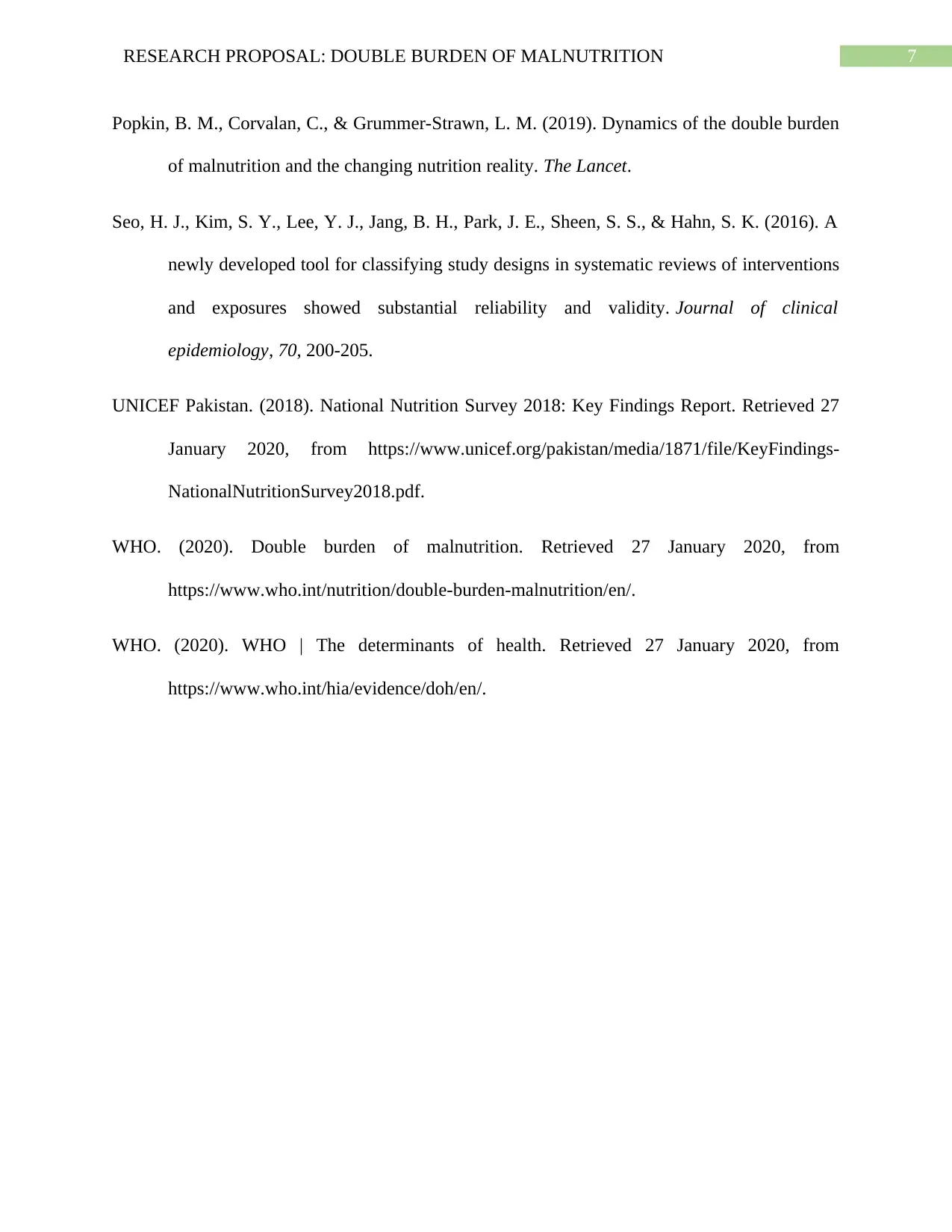
7RESEARCH PROPOSAL: DOUBLE BURDEN OF MALNUTRITION
Popkin, B. M., Corvalan, C., & Grummer-Strawn, L. M. (2019). Dynamics of the double burden
of malnutrition and the changing nutrition reality. The Lancet.
Seo, H. J., Kim, S. Y., Lee, Y. J., Jang, B. H., Park, J. E., Sheen, S. S., & Hahn, S. K. (2016). A
newly developed tool for classifying study designs in systematic reviews of interventions
and exposures showed substantial reliability and validity. Journal of clinical
epidemiology, 70, 200-205.
UNICEF Pakistan. (2018). National Nutrition Survey 2018: Key Findings Report. Retrieved 27
January 2020, from https://www.unicef.org/pakistan/media/1871/file/KeyFindings-
NationalNutritionSurvey2018.pdf.
WHO. (2020). Double burden of malnutrition. Retrieved 27 January 2020, from
https://www.who.int/nutrition/double-burden-malnutrition/en/.
WHO. (2020). WHO | The determinants of health. Retrieved 27 January 2020, from
https://www.who.int/hia/evidence/doh/en/.
Popkin, B. M., Corvalan, C., & Grummer-Strawn, L. M. (2019). Dynamics of the double burden
of malnutrition and the changing nutrition reality. The Lancet.
Seo, H. J., Kim, S. Y., Lee, Y. J., Jang, B. H., Park, J. E., Sheen, S. S., & Hahn, S. K. (2016). A
newly developed tool for classifying study designs in systematic reviews of interventions
and exposures showed substantial reliability and validity. Journal of clinical
epidemiology, 70, 200-205.
UNICEF Pakistan. (2018). National Nutrition Survey 2018: Key Findings Report. Retrieved 27
January 2020, from https://www.unicef.org/pakistan/media/1871/file/KeyFindings-
NationalNutritionSurvey2018.pdf.
WHO. (2020). Double burden of malnutrition. Retrieved 27 January 2020, from
https://www.who.int/nutrition/double-burden-malnutrition/en/.
WHO. (2020). WHO | The determinants of health. Retrieved 27 January 2020, from
https://www.who.int/hia/evidence/doh/en/.
1 out of 8
Your All-in-One AI-Powered Toolkit for Academic Success.
+13062052269
info@desklib.com
Available 24*7 on WhatsApp / Email
![[object Object]](/_next/static/media/star-bottom.7253800d.svg)
Unlock your academic potential
Copyright © 2020–2025 A2Z Services. All Rights Reserved. Developed and managed by ZUCOL.